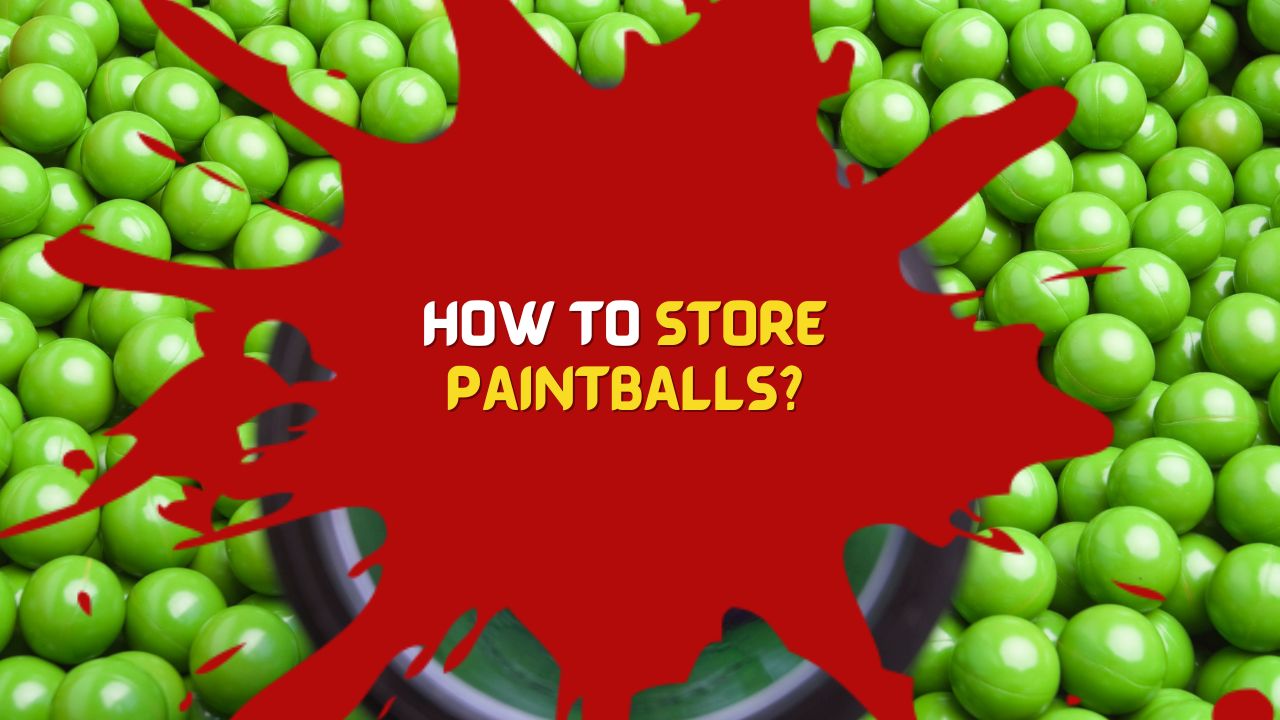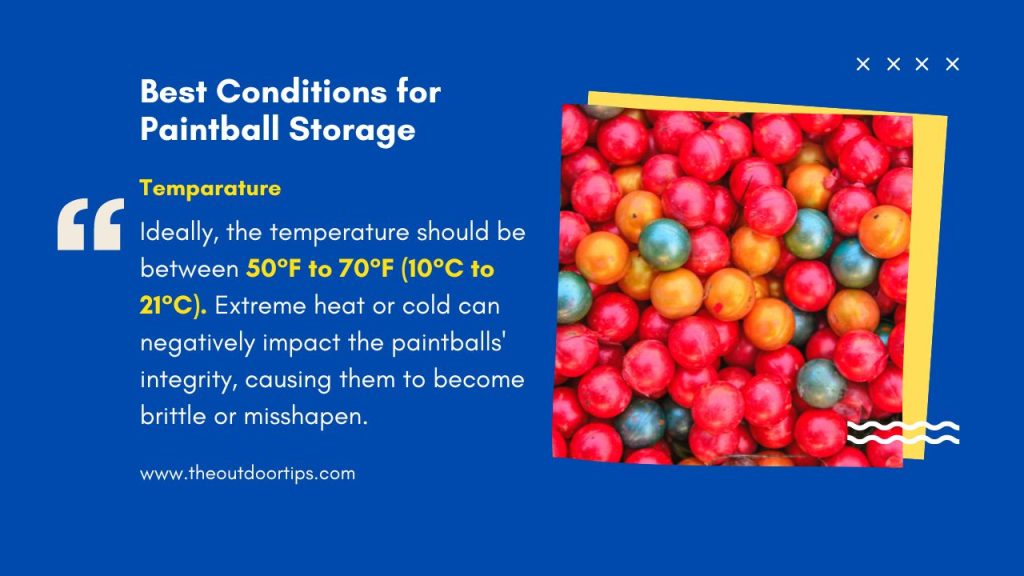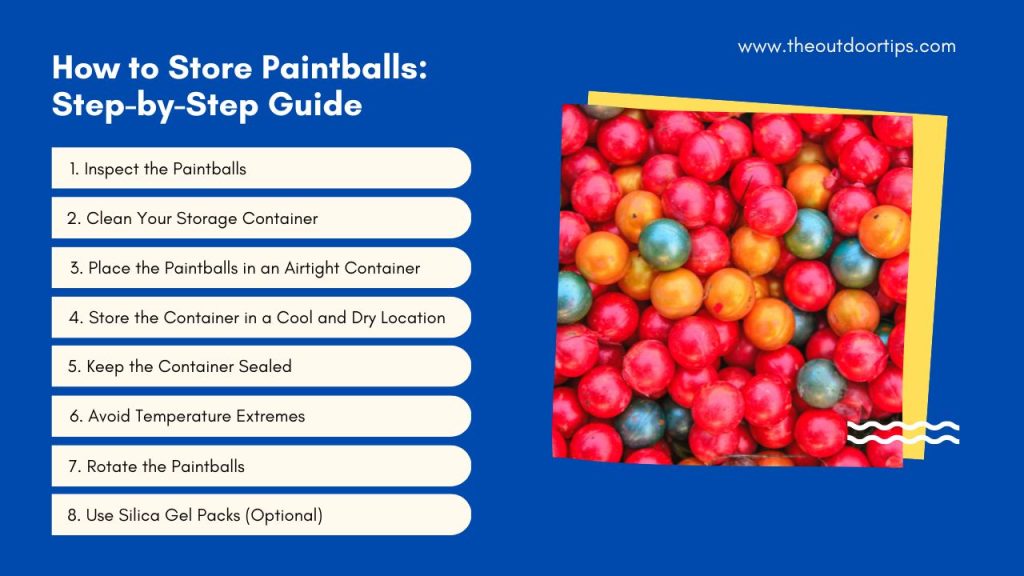Paintball is an exhilarating and action-packed sport that requires precision and accuracy. However, the performance of paintballs can be significantly affected by how they are stored. Proper paintball storage is essential for maintaining the roundness, consistency, and performance of paintballs. Storing them in a cool, dry, and well-ventilated environment, away from direct sunlight and extreme temperature fluctuations, helps prevent deformation, breakage, and degradation of the paint fill. Using airtight containers and rotating the paintballs regularly can ensure they remain fresh and ready for action on the paintball field.
In this comprehensive guide, we’ll explore the importance of storing paintballs correctly and provide you with essential tips and techniques to ensure your paintballs remain fresh and ready for action, game after game.

Why Proper Paintball Storage Matters
Before delving into the specifics of how to store paintballs, let’s understand why proper storage matters and how it impacts their performance on the paintball field:
1. Roundness and Consistency
High-quality paintballs are perfectly round, ensuring stable flight trajectories and accurate shots. When exposed to unfavorable storage conditions, paintballs can become deformed, leading to inconsistent flight paths and accuracy issues.
2. Brittleness and Breakage
Paintballs are made of gelatin, a water-soluble material. When exposed to heat, humidity, or extreme cold, paintballs can become brittle and prone to breaking inside the marker or hopper, causing jams and disruptions during gameplay.
3. Paint Fill Quality
The paint fill inside a paintball is the colorful liquid that marks the target upon impact. Proper storage helps maintain the integrity of the paint fill, ensuring it remains liquid and well-distributed within the paintball.
4. Cost-Effectiveness
Proper paintball storage extends the shelf life of your paintballs, allowing you to use them over an extended period. This can save you money in the long run, as you won’t need to replace spoiled paintballs as frequently.
5. Consistent Performance
Consistent paintball performance is crucial for honing your skills and mastering the game. Proper storage ensures that your paintballs perform consistently from the beginning of the game to the last shot.
Best Conditions for Paintball Storage
To keep your paintballs in top condition, it’s essential to store them in the right environment. Here are the best conditions for paintball storage:
1. Temperature
Maintain a stable temperature for paintball storage. Ideally, the temperature should be between 50°F to 70°F (10°C to 21°C). Extreme heat or cold can negatively impact the paintballs’ integrity, causing them to become brittle or misshapen.

2. Humidity
Low humidity levels are preferable for paintball storage. High humidity can cause the gelatin shells to absorb moisture, leading to swelling and deformation of the paintballs.
3. Light Exposure
Avoid direct exposure to sunlight or artificial light for extended periods. UV radiation can degrade the gelatin shells and the paint fill, compromising the paintballs’ performance.
4. Ventilation
While it’s essential to avoid excessive humidity, proper ventilation is necessary to prevent the paintballs from drying out. Store paintballs in a cool, dry, and well-ventilated space.
5. Container Type
Use airtight containers for paintball storage. Airtight containers help prevent air and moisture from reaching the paintballs, maintaining their freshness.
6. Avoid Extreme Changes
Avoid subjecting paintballs to sudden and extreme changes in temperature and humidity. Gradual changes are less likely to impact the paintballs negatively.
How to Store Paintballs: Step-by-Step Guide
Follow these steps to properly store your paintballs and ensure they remain fresh and ready for action:

1. Inspect the Paintballs
Before storing your paintballs, inspect them for any visible damage, deformities, or signs of degradation. Discard any paintballs with cracks, splits, or obvious defects, as they may break inside your marker during gameplay.
2. Clean Your Storage Container
If you are using a reusable container for paintball storage, ensure it is clean and free from any debris or moisture. Wash and dry the container thoroughly before use.
3. Place the Paintballs in an Airtight Container
Place the paintballs inside an airtight container, ensuring there is enough room to accommodate them without crowding. Overcrowding can cause friction between paintballs, potentially leading to chipping or deformation.
4. Store the Container in a Cool and Dry Location
Find a suitable location to store the container with the paintballs. A cool, dry, and well-ventilated room or storage area is ideal. Avoid placing the container near sources of heat, direct sunlight, or areas with high humidity.
5. Keep the Container Sealed
Ensure the container remains tightly sealed at all times. This prevents air and moisture from entering and affecting the paintballs’ quality.
6. Avoid Temperature Extremes
Avoid storing paintballs in locations prone to extreme temperature fluctuations, such as garages or sheds without climate control. Opt for a stable temperature environment within the recommended range.
7. Rotate the Paintballs
If you plan to store paintballs for an extended period, consider rotating them regularly. Remove the older paintballs and use them first before introducing new ones. This helps ensure that all your paintballs remain fresh and usable.
8. Use Silica Gel Packs (Optional)
To further protect the paintballs from humidity, consider placing silica gel packs inside the container. Silica gel absorbs moisture and helps maintain optimal storage conditions.
Common Mistakes to Avoid
While storing paintballs is relatively straightforward, there are some common mistakes to avoid to ensure your paintballs remain in peak condition:
1. Leaving Paintballs Exposed
Leaving paintballs exposed to air, sunlight, or humidity can degrade their quality and performance. Always store paintballs in a sealed container to protect them from external elements.
2. Using Damaged Containers
Using damaged or poorly sealed containers can allow air and moisture to enter, impacting the paintballs’ freshness. Ensure that the container you use is in good condition and seals tightly.
3. Ignoring the Expiration Date
Paintballs have a shelf life, and their quality may deteriorate over time. Pay attention to the expiration date on the paintball packaging and avoid using expired paintballs.
4. Storing Paintballs in the Marker or Hopper
Leaving paintballs inside the marker or hopper for an extended period can cause them to become misshapen or break, leading to potential marker malfunctions. Always store paintballs separately in a proper container.
5. Using Extreme Storage Conditions
Avoid storing paintballs in locations with extreme temperatures, high humidity, or direct sunlight. Extreme conditions can damage the paintballs and affect their performance.
Paintball Storage Myths Debunked
There are several myths and misconceptions surrounding paintball storage. Let’s debunk some of the common myths:
Myth 1: Freezing Paintballs
Some believe that freezing paintballs can help preserve their quality. However, freezing paintballs can cause the gelatin shells to become brittle, increasing the risk of breakage during gameplay.
Myth 2: Microwaving Paintballs
Microwaving paintballs is not an effective method for improving their performance. Microwaving can damage the gelatin shells and cause the paint fill to explode, rendering the paintballs unusable.
Myth 3: Heating Paintballs Before Play
Warming paintballs before use is unnecessary and may lead to deformities in the gelatin shells. Paintballs perform best at room temperature.
Frequently Asked Questions
1. Can I Store Paintballs in the Refrigerator?
While storing paintballs in the refrigerator may offer some protection from heat, it is not recommended. Refrigerators can have high humidity levels, which can negatively impact the paintballs’ quality.
2. How Long Can I Store Paintballs?
The shelf life of paintballs varies depending on the brand and storage conditions. Generally, paintballs can remain usable for several months to a year when stored properly.
3. Should I Store Paintballs in the Original Packaging?
Paintballs are usually sold in airtight packaging, which is suitable for short-term storage. However, for long-term storage, it’s best to transfer the paintballs to a reusable, airtight container.
4. Can I Use Old Paintballs?
Using old paintballs is not recommended, especially if they are past their expiration date. Old paintballs may have degraded in quality, leading to inconsistent flight paths and breakage issues.
5. How Often Should I Rotate Stored Paintballs?
If you plan to store paintballs for an extended period, consider rotating them every few months. This helps ensure that all the paintballs remain fresh and usable.
Final Thoughts: Fresh and Ready for Battle
Proper paintball storage is a crucial aspect of the sport that often gets overlooked. By following the guidelines outlined in this comprehensive guide, you can ensure that your paintballs remain fresh, consistent, and ready for action.
Maintain the recommended storage conditions, avoid common mistakes, and debunk the storage myths to maximize the performance and lifespan of your paintballs. With fresh and well-stored paintballs, you can focus on the thrill of the game, improve your skills, and enjoy an exhilarating paintball experience every time you step onto the field.
